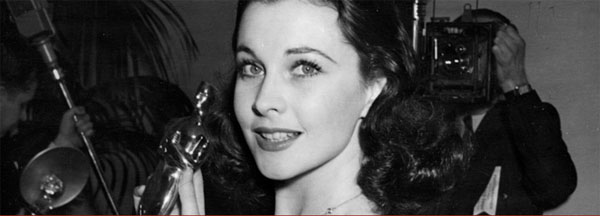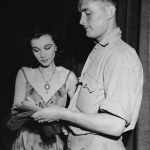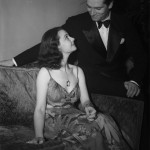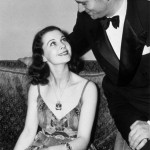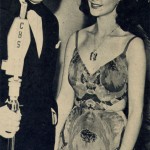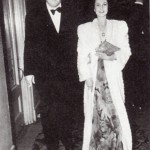At the Oscars, fashion is almost more important than the films. Not many celebrities dare to show up looking like hobos or circus clowns, and when they do, they are slashed by the people of E! as the “worst dressed” abominations of the evening. Never mind that the Oscars are really supposed to be about cinematic achievement. However, it’s true that fashion and the Academy Awards have always gone together.
In 1940, Vivien Leigh was the belle of the ball. Her performance in Gone with the Wind was a guaranteed winner and her ensemble for the evening is still written about in retrospectives about Oscar fashion history. Her dress was designed by Irene Gibbons of the famous Hollywood department store Bullock’s Wilshire. Irene was considered the Coco Chanel of American fashion and frequently dressed the likes of Carole Lombard, Eddie Goetz and Marlene Dietrich. Bronwyn Cosgrave describes Vivien’s dress in detail in the book Made For Each Other: Fashion and the Academy Awards
Irene’s program described Leigh’s Oscar dress, which debuted as look fourteen on a pale blond model, simply as “Red Poppy Evening Gown.” Green-stemmed red poppies exploded like fireworks upon the long chiffon gown. Its vibrant floral print carried on a theme Irene had been exploring for a while. She produced sexy gowns drenched with big, bold blooms including a frisky white dance dress dotted with perky black-eyed Susans in which Ginger Rogers boogied alongside Fred Astaire in 1937’s Shall We Dance. A year later, at a San Francisco hotel party, Marlene Dietrich caused a sensation in a low-cut, spaghetti-strapped Irene frock of white silk enlivened with purple hydrangeas. “The bigger, the better” was Irene’s pattern philosophy.
…Within its bodice was a light, inner support necessitating that nothing need be worn beneath it. “[Irene’s] soft crêpes and chiffons were meant to be worn without a brassiere—a discreet construction underneath them lifted the breasts delicately,” wrote Hollywood costume expert David Chierichetti of the frocks Irene built for maximum comfort because so many of her movie star clients, like Leigh, spent long days on film sets bound in tight-fitting, corset-topped period costumes.On the night of the twelfth Academy Awards, between Red Poppy Evening Gown and Leigh’s skin mingled merely the rose and jasmine scent of Jean Patou’s Joy, her favorite perfume. She splashed it on and fastened an aquamarine pendant. Olivier had purchased the semiprecious piece in New York from Van Cleef & Arpels, the Fifth Avenue jeweler, and sent it to Leigh in Los Angeles as a token of his affection as she suffered through Wind. On Oscar night it hung from a long gold chain and drew attention to the plunging bodice of Irene’s dress. Like a trophy medallion, it displayed that after a tough seven months of portraying Scarlett O’Hara, Leigh was finally free. She and Olivier set off by limousine to a pre–Academy Awards cocktail party at David Selznick’s sprawling home on Summit Drive. “Everybody was keyed up—they all came in limousines,” recalled Irene Mayer Selznick, David’s wife. Celebrating at Selznick’s lofty abode, Leigh discovered she had won an Academy Award. In banner headlines, the Los Angeles Times’ early edition published results it was meant to print the following day—Wind had set an Academy record, winning an unprecedented nine Oscars. Supercharged by the news, Selznick hustled Leigh, Olivier, Clark Gable, and Olivia de Havilland into the back of a limousine bound for the ceremony at the Ambassador Hotel’s nightclub, the Cocoanut Grove. The Twelfth Academy Awards, February 29, 1940. Veiled in stardust, gowned by Irene, Leigh was ushered into the Ambassador’s lobby by David Selznick as a “near riot of admirers” rushed toward them, wrote Variety’s Alta Durant. Leigh, noted the columnist, was the “star” of an illustrious Academy Awards.
[Note from Kendra] A a color photo by Peter Stackpole housed in the Margaret Herrick Library in Beverly Hills reveals Vivien’s pendant to have been topaz rather than aquamarine.
Vivien was able to keep the Irene gown and its lightweight material made it an ideal costume to perform in while touring North Africa during the war (see photo below).

